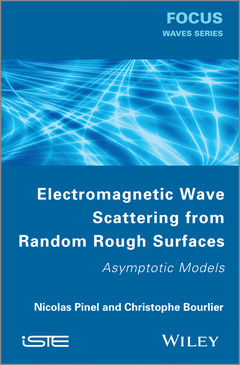Description
Electromagnetic Wave Scattering from Random Rough Surfaces
Asymptotic Models
Authors: Pinel Nicolas, Boulier Christophe
Language: English
Subject for Electromagnetic Wave Scattering from Random Rough Surfaces:
171.59 €
In Print (Delivery period: 14 days).
Add to cart265 p. · 16.3x24.1 cm · Hardback
Description
/li>Contents
/li>Biography
/li>
Focusing on the case of random rough surfaces, this book presents classical asymptotic models used to describe electromagnetic wave scattering. The authors begin by outlining the basic concepts relevant to the topic before moving on to look at the derivation of the scattered field under asymptotic models, based on the Kirchhoff-tangent plane, in order to calculate both the scattered field and the statistical average intensity.
More elaborated asymptotic models are also described for dealing with specific cases, and numerical results are presented to illustrate these models. Comparisons with a reference numerical method are made to confirm and refine the theoretical validity domains.
The final chapter derives the expressions of the scattering intensities of random rough surfaces under the asymptotic models. Its expressions are given for their incoherent contributions, from statistical calculations. These results are then compared with numerical computations using a Monte-Carlo process, as well as with experimental models, for sea surface backscattering.
Contents
1. Electromagnetic Wave Scattering from Random Rough Surfaces: Basics.
2. Derivation of the Scattered Field under Asymptotic Models.
3. Derivation of the Normalized Radar Cross-Section under Asymptotic Models.
APPENDIX 1. Far-Field Scattered Fields under the Method of Stationary Phase.
APPENDIX 2. Calculation of the Scattering Coefficients under the GO for 3D Problems.
About the Authors
Nicolas Pinel worked as a Research Engineer at the IETR (Institut d?Electronique et de Télécommunications de Rennes) laboratory at Polytech Nantes (University of Nantes, France) before joining Alyotech Technologies in Rennes, France, in July 2013. His research interests are in the areas of radar and optical remote sensing, scattering and propagation. In particular, he works on asymptotic methods of electromagnetic wave scattering from random rough surfaces and layers.
Christophe Bourlier works at the IETR (Institut d?Electronique et de Télécommunications de Rennes) laboratory at Polytech Nantes (University of Nantes, France) and is also a Researcher at the French National Center for Scientific Research (CNRS) on electromagnetic wave scattering from rough surfaces and objects for remote sensing applications and radar signatures. He is the author of more than 160 journal articles and conference papers.
PREFACE ix
INTRODUCTION x
CHAPTER 1. ELECTROMAGNETIC WAVE SCATTERING FROM RANDOM ROUGH SURFACES: BASICS 1
1.1. Introduction 1
1.2. Generalities 2
1.2.1. Maxwell equations and boundary conditions 2
1.2.2. Propagation of a plane wave (Helmholtz equation and plane wave) 5
1.2.3. Incident wave at an interface: polarization 7
1.3. Random rough surfaces: statistical description and electromagnetic roughness 12
1.3.1. Statistical description of random rough surfaces 12
1.3.2. Specific case of sea surfaces 19
1.3.3. Electromagnetic roughness and Rayleigh roughness criterion 21
1.4. Scattering of electromagnetic waves from rough surfaces: basics 28
1.4.1. Presentation of the problem (2D/3D) 28
1.4.2. Huygens’ principle and extinction theorem 30
1.4.3. Green functions (2D/3D) 33
1.4.4. Scattered powers and scattering coefficients 36
CHAPTER 2. DERIVATION OF THE SCATTERED FIELD UNDER ASYMPTOTIC MODELS 41
2.1. Bibliography on existing models 42
2.1.1. Introduction 42
2.1.2. Rigorous models 43
2.1.3. Asymptotic models 44
2.1.4. General properties of scattering 52
2.1.5. A few details on the KA and the GO 55
2.2. Scattering in reflection and transmission under the KA with shadowing effect 58
2.2.1. KA in reflection and transmission with shadowing effect for 2D problems 58
2.2.2. Extension of the KA model to 3D problems 62
2.3. Scattering in reflection for 3D problems under various asymptotic models 69
2.3.1. Context and specific notations 69
2.3.2. The small perturbation model 71
2.3.3. The Kirchhoff approximation–high-frequency regime 73
2.3.4. The weighted curvature approximation 75
2.3.5. The small slope approximation 75
2.3.6. The local curvature approximation 76
2.3.7. The resonant curvature approximation 76
2.3.8. Validation of the different asymptotic numerical models for 2D problems 77
CHAPTER 3. DERIVATION OF THE NORMALIZED RADAR CROSS-SECTION UNDER ASYMPTOTIC MODELS 81
3.1. Derivation of incoherent normalized radar cross-section under the GO for 2D problems 82
3.1.1. Incoherent NRCS under the GO with shadowing effect for 2D problems 82
3.1.2. Calculation of the bistatic shadowing functions in reflection and transmission 86
3.2. General properties and energy conservation of the GO for 2D problems 97
3.2.1. General properties of the GO for 2D problems 97
3.2.2. Study of energy conservation under the GO for 2D problems 99
3.3. Scattering coefficients under the GO with shadowing effect for 3D problems 108
3.4. Energy conservation of the GO model for 3D problems 111
3.4.1. Case of a perfectly conducting lower medium 112
3.4.2. Case of a lossless dielectric lower medium 115
3.5. Scattering in reflection for 3D problems under various asymptotic models 117
3.5.1. Expression of the NRCS under the SPM1 118
3.5.2. Expression of the NRCS under the GO 118
3.5.3. Expression of the NRCS under the SSA 119
3.5.4. Validation and comparison of the different asymptotic analytical models for 2D problems 119
3.5.5. Comparison between numerical and analytical asymptotic models for 3D problems 121
APPENDIX 1. FAR-FIELD SCATTERED FIELDS UNDER THE METHOD OF STATIONARY PHASE 125
APPENDIX 2. CALCULATION OF THE SCATTERING COEFFICIENTS UNDER THE GO FOR 3D PROBLEMS 131
BIBLIOGRAPHY 137
INDEX 149
Dr. Nicolas Pinel is PhD in the Radar team of IREENA Laboratory at University of? Nantes Angers Le Mans, France.
Christophe Bourlier is works at IREENA (Institut de Recherche en Electrotechnique et Electronique de Nantes Atlantique, France) Laboratory, University of Nantes, France.




